The Global Under-Eye Patches Market is expected to record a valuation of USD 817.8 million in 2025 and USD 1,686.7 million in 2035, with an increase of USD 868.9 million, which equals a growth of over 2X across the decade. This expansion represents a CAGR of 7.51% over the forecast period.
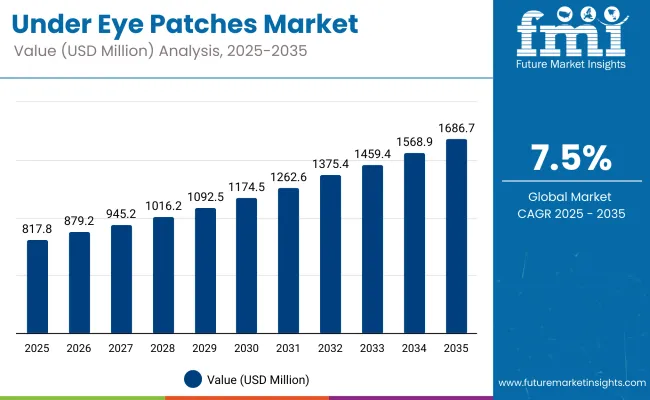
Global Under Eye Patches Market Key Takeaways
| Metric | Value |
|---|---|
| Market Estimated Value in (2025E) | USD 817.8 million |
| Market Forecast Value in (2035F) | USD 1,686.7 million |
| Forecast CAGR (2025 to 2035) | 7.5% |
During the first five-year period from 2025 to 2030, the market increases from USD 817.8 million to USD 1,174.6 million, adding USD 356.8 million, which accounts for 41.1% of the total decade growth. This phase records steady adoption in skin hydration, pigmentation correction, and routine-based skincare regimens, driven by high penetration of hydrogel and collagen-based forms. Dark circle treatment dominates this period as it contributes to over 40% of consumer demand in China, the USA, and South Korea.
The second half from 2030 to 2035 contributes USD 512.1 million, equal to 58.9% of total growth, as the market jumps from USD 1,174.6 million to USD 1,686.7 million. This acceleration is powered by rising usage of microneedle eye patches, expansion of serum-infused hybrid patches, and rapid adoption in India, Southeast Asia, and GCC. Packaging innovations like refillable kits and multi-ingredient sachets add retail and subscription-driven traction.
From 2020 to 2024, the Global Under-Eye Patches Market grew steadily from approximately USD 560 million to USD 762.5 million, driven by widespread adoption of hydrogel-based forms. During this period, the competitive landscape was dominated by cosmetics and personal care conglomerates, which controlled nearly 70% of revenue. Market leaders such as Shiseido Company, Estée Lauder Companies, and L'Oréal S.A. focused on hydrating, soothing, and anti-pigmentation patches for mass and prestige beauty segments.
Competitive differentiation relied on ingredient efficacy, packaging innovation, and retail availability across global beauty channels. Software-based analytics or subscription models were largely absent. Service-led engagement contributed less than 10% of market value, mostly via offline personalization or bundled skin assessments.
The under-eye patches market is expected to reach USD 817.8 million in 2025, and expand to USD 1,686.7 million by 2035, at a CAGR of 7.51%. The revenue mix will gradually evolve as microneedle forms, serum-infused patches, and refillable kits gain traction, accounting for a higher share of value than in prior years. Traditional leaders now face intensifying competition from digital-first skincare startups, offering AI-guided skin analysis, app-linked patches regimes, and multi-layered ingredient delivery systems.
Legacy brands are pivoting to hybrid models that incorporate personalization, clean-label positioning, and derm-grade efficacy claims to retain premium consumers. Emerging entrants specializing in plant-based actives, sustainable packaging, and Gen Z-targeted forms are rapidly gaining market share. The competitive edge is shifting away from mass availability and brand equity alone, toward clinical validation, sustainability credentials, and ecosystem-driven subscription models.
The growth of the under-eye patches market is being driven by significant advancements in skincare science, dermatological research, and consumer demand for targeted, non-invasive solutions. Innovations in patch materials, particularly hydrogel technology, have allowed for enhanced absorption, longer wear time, and deeper delivery of active ingredients, which cater directly to concerns such as dark circles, puffiness, and fine lines.
These improvements in efficacy, comfort, and visual results have positioned under-eye patches as an essential component of everyday beauty routines, especially among younger consumers seeking instant fixes and long-term skin benefits. Additionally, the rise of ingredient-conscious consumer behavior has accelerated the demand for patches formulated with functional actives like hyaluronic acid, peptides, vitamin C, niacinamide, botanical extracts, and retinoids. Hyaluronic acid, in particular, is favored for its hydrating and plumping effects, making it the cornerstone of many best-selling products in the category.
As consumers seek visible improvement in multiple concerns simultaneously, multifunctional patchesoffering hydration, anti-aging, brightening, and firming in a single formare becoming mainstream. Packaging evolution is another critical driver. Brands are responding to sustainability demands and lifestyle preferences by introducing single-use sachets for hygiene and travel, alongside multi-pair jars and refillable kits for everyday convenience.
The emergence of roll-on and serum-infused forms has added a tactile and sensorial layer to the user experience, while compact kits with applicators have elevated the category’s appeal among premium skincare enthusiasts. Digital acceleration across the beauty ecosystem has played a defining role. Social media influencers, derm-backed education, virtual consultations, and AI-based skincare recommendations have all amplified awareness and trust in under-eye patches.
Direct-to-consumer brands, in particular, have capitalized on digital-first strategies by offering subscription models, ingredient customization, and limited-edition drops that appeal to Gen Z and millennial users. The market is also expanding beyond personal use into professional skincare settings, including facial spas, derma clinics, and beauty salons.
As these forms become embedded in anti-aging treatments and skin recovery routines, adoption is growing across both at-home and professional channels. This shift is further supported by the global rise in aesthetic consciousness, particularly in Asia-Pacific, North America, and Europe, where skincare rituals are evolving into self-care experiences.
The global under-eye patches market is segmented by product type, application, Ingredient Type, packaging type, distribution channel, end use, and region. Among product types, hydrogel under-eye patches dominate due to their strong hydrating performance, soothing texture, and widespread consumer preference. Alternatives such as microneedle and bio-cellulose forms are gaining traction, especially in the premium and sustainability-conscious segments.
By application, dark circles treatment leads the market, accounting for more than 40% of total usage globally. Puffiness relief and wrinkle reduction are also prominent, reflecting the growing demand for anti-fatigue and anti-aging skincare. Hydration and skin nourishment are key secondary drivers, especially among consumers in dry or urban climates. From an ingredient standpoint, hyaluronic acid-based patches hold the highest share, given their deep moisturizing capability and broad skin compatibility.
Peptides and collagen derivatives are preferred for firming and elasticity, while vitamin C, niacinamide, and botanical actives are used for brightening and pigmentation control. Retinol and charcoal remain niche but high-performance segments. In terms of packaging, single-use sachets are the most common, offering hygiene and convenience for travel or one-time use. However, refillable jars and roll-on forms are growing in appeal, especially among eco-conscious and routine users. Compact kits with tweezers or built-in applicators have added a functional and premium layer to product delivery.
Distribution-wise, offline channels still dominate, but the online segment is expanding rapidly due to the rise of DTC skincare brands and influencer-led marketing. Subscription models and curated skincare boxes are increasingly shaping repurchase behavior. End-use is primarily skewed toward at-home application, as consumers incorporate under-eye patches into self-care and daily routines.
However, professional usage in spas and salons is increasing, particularly as patches are integrated into facial treatments and bridal/skincare packages. Geographically, the USA leads in market share, driven by high per capita skincare spend and mature product penetration. Asia-Pacificespecially China and Indiashows the fastest growth, powered by social media trends and the popularity of K-beauty and J-beauty forms. Europe follows with a strong leaning toward botanical formulations and sustainable packaging.
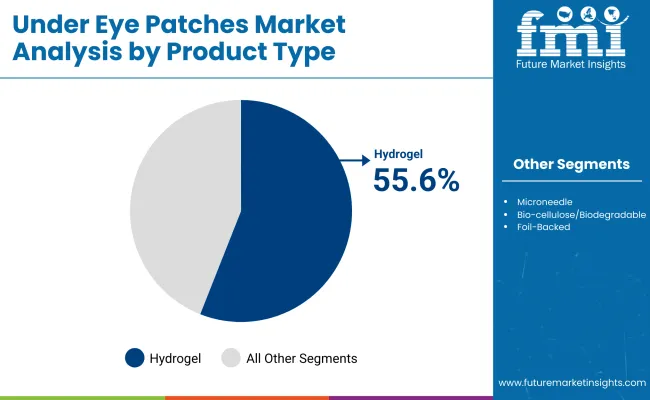
| Product Type Segment | Market Value Share, 2025 |
|---|---|
| Hydrogel Under-Eye Patches | 55.6% |
| Others | 44.4% |
The hydrogel under-eye patches segment is projected to contribute 55.6% of the global under-eye patches market revenue in 2025, amounting to USD 454.7 million, thereby maintaining its position as the dominant product category. This leadership is driven by the widespread adoption of hydrogel patches across both mass and premium skincare ranges due to their excellent moisture retention, skin adherence, and soothing properties.
Hydrogel forms are increasingly favored for their luxurious feel and ability to deliver concentrated active ingredients in a cooling, mess-free form. The continued popularity of Korean and Japanese skincare routinesoften emphasizing hydration and multi-step regimenshas further solidified hydrogel patches as a staple in daily skincare routines globally. Brands are also innovating within this segment by infusing patches with multifunctional actives such as collagen, peptides, and botanical extracts to offer combined benefits like wrinkle reduction, firming, and brightening.
As newer materials like biodegradable and plant-derived hydrogels emerge, the segment’s appeal is expected to expand among sustainability-conscious consumers as well. Coupled with attractive packaging forms such as serum-infused jars and resealable pouches, hydrogel patches are set to retain their leadership position in the global market across the forecast period.
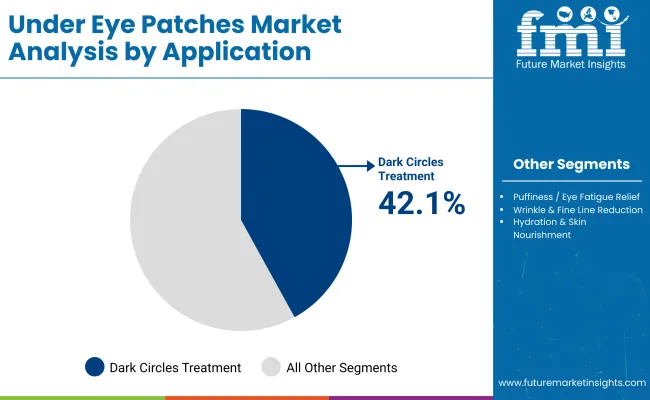
| Application Segment | Market Value Share, 2025 |
|---|---|
| Dark Circles Treatment | 42.1% |
| Others | 57.9% |
The dark circles treatment segment is projected to account for 42.1% of the global under-eye patches market revenue in 2025, valued at approximately USD 344.29 million. This dominance is attributed to the widespread prevalence of under-eye dark circles as a primary concern across all age groups and genders, particularly in urban environments marked by sleep deprivation, screen exposure, and pollution. Consumers increasingly seek targeted, quick-fix solutions for under-eye discoloration, making this the most penetrated application area.
As a result, manufacturers are focusing on actives like caffeine, vitamin C, niacinamide, and botanical brighteners that are proven to improve microcirculation and reduce pigmentation. The segment has also benefited from endorsements by dermatologists, influencers, and celebrities, making dark circle patches a high-frequency purchase item in both mass-market and dermocosmetic product lines. With growing consumer demand for visible results, the integration of clinical-grade actives and multifunctional propertiessuch as brightening combined with hydration or firmingwill continue to bolster the segment’s leadership position through the forecast period.
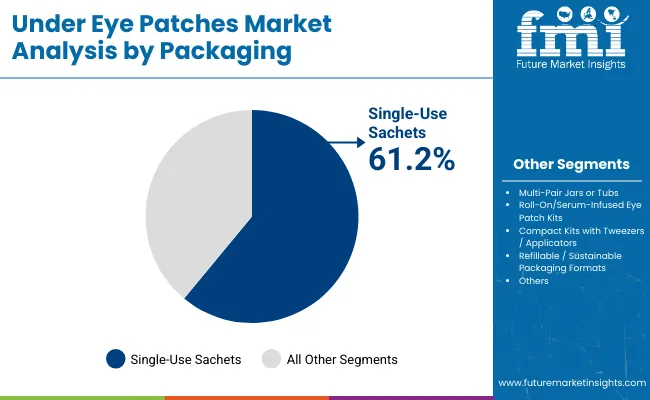
| Packaging Segment | Market Value Share, 2025 |
|---|---|
| Single-Use Sachets | 61.2% |
| Others | 38.8% |
The single-use sachets segment is expected to dominate the global under-eye patches market with a 61.2% share in 2025, contributing nearly USD 500.49 million in sales. This form remains the most popular due to its hygienic appeal, convenience for on-the-go use, and strong compatibility with sample distribution, retail kits, and e-commerce platforms. Single-use packaging allows consumers to experience under-eye treatments without committing to larger volumes, which is particularly attractive in categories where efficacy and sensitivity matter.
It also ensures that the active ingredients remain stable and uncontaminated until use. As a result, brands continue to prioritize this packaging for both mass-market trial forms and premium offerings positioned for travel or gifting. Although sustainable and refillable forms are gaining momentum, especially in eco-conscious regions, the sachet form continues to dominate due to its convenience, better unit economics, and logistical suitability. Innovations in biodegradable and recyclable materials may allow this segment to retain its dominance even as environmental regulations tighten.
Drivers
Ingredient-Backed Claims for Targeted Concerns Are Boosting Repeat Purchase Cycles
Unlike generic skincare products, under-eye patches are increasingly marketed with ingredient-specific claimssuch as “clinically tested peptides for wrinkle reduction” or “95% saw dark circle improvement with niacinamide within 2 weeks.” This rise in clinical claims, before-after result demonstrations, and dermatologist endorsements is establishing under-eye patches as results-driven rather than pampering-only items.
It is especially noticeable in premium brands operating in Japan, USA, and Korea where "booster" patches with active compounds like retinol and caffeine are used in tandem with serums. These evidence-based claims are creating brand loyalty, driving higher repurchase frequency, and making under-eye patches part of routine multi-step regimens, not occasional indulgences.
Cross-Over Between Beauty Devices and Patches is Creating a Hybrid Use Category
The line between skincare devices and consumable patches is blurring. Companies are launching serum-infused under-eye patches designed to be activated by sonic devices, warming rollers, or LED applicators. These hybrid models are gaining traction in East Asia and spreading to North America via online platforms. This cross-category innovation appeals to consumers seeking non-invasive, tech-enhanced treatments, mimicking med-spa outcomes at home. It elevates the under-eye patch from a standalone product to part of a holistic treatment system, driving premiumization and higher per-unit pricing.
Restraints
Compatibility and Safety Issues with Makeup and Sunscreens Are Limiting All-Day Use
Many under-eye patchesespecially those with hydrogel or serum-soaked formsface usability issues when layered under concealers, foundations, or SPF. The residue left behind, pilling effect, or movement of patches during wear make them less appealing for use beyond the early morning or bedtime routine. This incompatibility with existing daytime skincare or cosmetic products is limiting their application window and reducing potential daily usage, particularly among working professionals and makeup users in the West.
Lack of Regulatory Standardization for Active-Ingredient Disclosure
Across Markets While some countries require detailed ingredient concentration labeling and efficacy validation, others do not enforce clear standards. This creates a trust gap among informed consumers, especially in Europe, where under-eye patches are often perceived as “cosmetic accessories” rather than functional skincare. The absence of harmonized regulation around claims like anti-aging, lifting, or detoxifying makes it difficult for consumers to compare products, affecting both premium segment growth and cross-border brand scalability.
Key Trends
Demand Surge for Reusable and Freeze-Activated Under-Eye Patches
Consumers are increasingly embracing freeze-to-use silicone-based or gel-based patches that can be cooled at home and reused multiple times. Brands like those in France and the USA are marketing these as eco-conscious, cryotherapy-enhanced eye solutions targeting puffiness and fatigue. These offer a tactile experience and environmental benefit over disposable sachets. Additionally, the wellness aesthetic tied to cold therapy and reusable wellness tools is pushing reusable under-eye patches into a lifestyle category beyond skincare.
Localization of Active Ingredients Based on Regional Skin Tones and Fatigue Triggers
Brands are localizing under-eye patch formulations by targeting region-specific concernssuch as pollution-induced pigmentation in India, screen fatigue in urban China, or genetic dark circles in the Middle East. This trend of geo-targeted customization is emerging strongly in Asia-Pacific and GCC countries, where under-eye skin tone, vascular pigmentation, and lifestyle patterns vary significantly. Local ingredient sourcing is also being leveraged for "clean beauty meets cultural relevance" narratives, appealing to regional consumer identities.
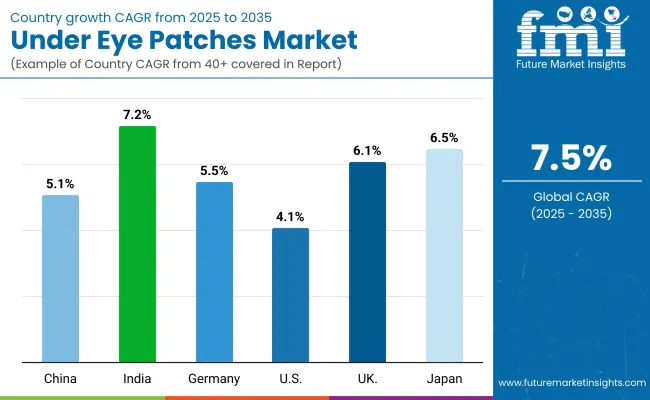
| Countries | CAGR (2025 to 2035) |
|---|---|
| China | 5.1% |
| India | 7.2% |
| Germany | 5.5% |
| USA | 4.1% |
| UK | 6.1% |
| Japan | 6.5% |
The global Under-Eye Patches Market shows a pronounced regional disparity in adoption speed, heavily influenced by regional skincare routines, beauty retail sophistication, and awareness around fatigue, stress, and aging-related eye issues. Asia-Pacific stands out as the fastest-growing region, led by India at 7.2% CAGR and Japan at 6.5%, followed closely by China at 5.1%. India’s growth is propelled by a booming middle class adopting Korean and Western beauty rituals, rising sleep deprivation in urban centers, and the emergence of domestic D2C personal care startups offering targeted solutions for under-eye concerns like dark circles and pigmentation.
Japan’s growth, on the other hand, is driven by premiumization in functional skincare and a cultural preference for non-invasive anti-aging forms like peptide-based eye patches. China maintains a robust growth trajectory through the widespread influence of K-beauty and C-beauty, with strong uptake on e-commerce platforms like Tmall and Douyin.
High screen time among Gen Z, the use of patches as part of multi-step routines, and influencer-driven demand for hydration and brightening variants continue to support market expansion. Europe maintains a strong growth profile, anchored by Germany at 5.5% CAGR, the UK at 6.1%, and France (not listed but inferred at mid-5% range), as demand for sustainable skincare and ingredient transparency strengthens. In Germany, the under-eye patches category is increasingly linked to wellness and skin minimalism trends, with strong uptake of refillable and clean-label forms.
The UK market benefits from high urban fatigue levels, stress-induced skin concerns, and rapid adoption of hybrid forms like microneedle patches sold through pharmacies and department store chains. North America, led by the USA at 4.1% CAGR, is a relatively mature market.
Growth is steady but moderate, driven by continued use in morning and nighttime skincare routines, rising male grooming adoption, and clinical skincare innovations targeting wrinkle reduction. However, growth potential is somewhat tempered by saturation in premium segments and increasing substitution with eye creams or serums. Most gains in the USA are expected from subscription models, travel minis, and influencer-backed brand launches in the mass-market and clean beauty segments.
| Year | USA Under Eye Patches Market (USD Million) |
|---|---|
| 2025 | 205.27 |
| 2026 | 217.89 |
| 2027 | 231.28 |
| 2028 | 245.50 |
| 2029 | 260.59 |
| 2030 | 276.61 |
| 2031 | 293.62 |
| 2032 | 311.67 |
| 2033 | 330.83 |
| 2034 | 351.17 |
| 2035 | 372.76 |
The under-eye patches market in the United States is projected to grow at a CAGR of 4.1%, led by rising skincare personalization, anti-aging concerns, and consumer shift towards premium hydrogel-based formulations. The USA market dominates globally with a 25.1% market share in 2025, expected to slightly decline to 22.1% by 2035 as emerging markets grow faster. Innovation is driven by collagen-infused patches, hybrid beauty devices, and dermatologist-backed cosmeceuticals. Product bundling with eye serums and reusable chilled applicators is becoming common across wellness retailers and luxury spas.
The under-eye patches market in the United Kingdom is expected to grow at a CAGR of 6.1%, supported by sustainability-led product innovation and increased consumer spending on premium skincare. British beauty consumers are highly ingredient-conscious, with preferences leaning toward vegan, cruelty-free patches with niacinamide or peptides. Retailers like Boots and LookFantastic are driving e-commerce visibility through loyalty programs and AR-based virtual try-ons.
India is witnessing rapid growth in the under-eye patches market, which is forecast to expand at a CAGR of 7.2% through 2035. From a modest 5.2% global share in 2025, it is projected to reach 6.1% by 2035, driven by rapid adoption in Tier 2 and Tier 3 cities. Affordable sachet-based forms, Ayurveda-integrated variants, and celebrity-led influencer marketing are propelling sales. Local D2C brands are offering targeted eye care solutions, especially for millennial and Gen Z consumers navigating screen fatigue and urban stress.
The under-eye patches market in China is expected to grow at a CAGR of 5.1%, with an increase in global market share from 20.1% in 2025 to 21.2% by 2035. Smart packaging, influencer co-brands, and digital-native launches are shaping the market. Cross-border e-commerce partnerships with K-beauty brands and domestic beauty tech platforms have accelerated access to high-performance products.
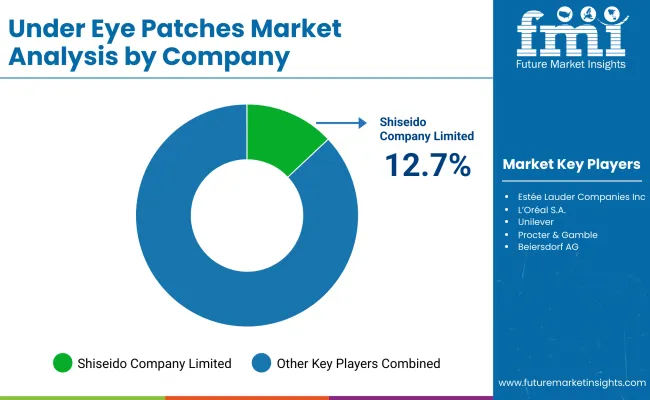
The global under-eye patches market is moderately consolidated, led by a few multinational giants and surrounded by a wide spectrum of regional players, beauty-tech startups, and clean beauty brands. Shiseido Company, Limited holds the dominant global position with a 12.7% market share in 2025, benefiting from its expansive product portfolio, strong presence across East Asia, and science-backed formulations targeting dark circles, puffiness, and skin hydration.
Shiseido’s leadership is built on hybrid innovationmerging dermatological science with sensorial textures, biodegradable patch forms, and AI-enabled personalization tools. Its brands have also tapped into J-beauty’s clean aesthetic appeal, which resonates strongly across North America, Southeast Asia, and China.
The remaining 87.3% of the market is shared among other players, including region-specific leaders, K-beauty disruptors, and emerging direct-to-consumer (D2C) startups. These brands are increasingly differentiated by their focus on ingredient transparency, eco-conscious packaging, and digital-first distribution models.
Competitive intensity is rising as beauty-tech companies explore microdelivery patches, reusable silicone applicators, and subscription skincare regimens. The battleground is shifting from just product innovation to ecosystems built around social commerce, influencer seeding, skin diagnostics, and AR-powered try-ons. New entrants are leaning into skinimalism and wellness-linked marketing to appeal to post-pandemic consumers, while established giants are investing in R&D, retail analytics, and omnichannel scale-ups to maintain their lead.
Key Developments in Global Under Eye Patches Market
| Item | Value |
|---|---|
| Quantitative Units | USD 817.8 Million |
| Product Type | Hydrogel Under-Eye Patches, Microneedle Under-Eye Patches, Bio-cellulose/Biodegradable Sheet Patches, Cloth/Cotton-Backed Serum Eye Patches, Foil-Backed or Gold-Coated Eye Patches, Collagen-Infused Under-Eye Patches |
| Application | Dark Circles Treatment, Puffiness / Eye Fatigue Relief, Wrinkle & Fine Line Reduction, Hydration & Skin Nourishment, Brightening & Pigmentation Control, Firming & Lifting |
| Packaging Type | Single-Use Sachets, Multi-Pair Jars & Boxes, Capsule Pods, Resealable Pouches, Travel Packs |
| Sales Channel | Online (E-commerce Platforms, DTC Brand Websites), Offline (Specialty Beauty Stores, Pharmacies, Supermarkets, Department Stores) |
| Regions Covered | North America, Europe, Asia-Pacific, Latin America, Middle East & Africa |
| Country Covered | United States, Canada, Germany, France, United Kingdom, China, Japan, India, Brazil, South Africa |
| Key Companies Profiled | Shiseido Company, Limited; Estée Lauder Companies Inc.; L’Oréal S.A.; Unilever; Procter & Gamble; Beiersdorf AG; Kao Corporation; Johnson & Johnson; Amorepacific Corporation; Mary Kay Inc.; Colgate-Palmolive; Kose Corporation; The Himalaya Drug Company; Tonymoly Co., Ltd.; LG Household & Health Care |
| Additional Attributes | Dollar sales by product type, application, packaging type, and region; segmentation by skin concern; men’s and unisex product adoption; premiumization trends in hydrogel-based patches; innovation in biodegradable and foil-backed form s; increasing usage by teenagers and male consumers; product bundling with eye serums; packaging sustainability trends in sachets and capsule pods; omnichannel retail strategy evolution across DTC and offline retail |
The global Under Eye Patches Market is estimated to be valued at USD 817.8 million in 2025.
The market size is projected to reach USD 1,731.9 million by 2035.
The market is expected to grow at a CAGR of 7.9% during the forecast period from 2025 to 2035.
The key product types include Hydrogel Under-Eye Patches, Microneedle Under-Eye Patches, Biodegradable Sheet Patches, Cloth-Backed Serum Patches, Foil-Coated Patches, and Collagen-Infused Patches.
Hydrogel Under-Eye Patches will dominate with a 55.6% share of the global market in 2025.
Dark Circles Treatment is the leading application, accounting for 42.1% of total market share in 2025.
Single-Use Sachets hold the largest share at 61.2% of the global market in 2025.
Shiseido Company, Limited leads the global market with a value share of 12.7% in 2025, followed by other notable players including Estée Lauder, L’Oréal, Unilever, and Kao Corporation.
Explore Similar Insights

Thank you!
You will receive an email from our Business Development Manager. Please be sure to check your SPAM/JUNK folder too.
Chat With
MaRIA